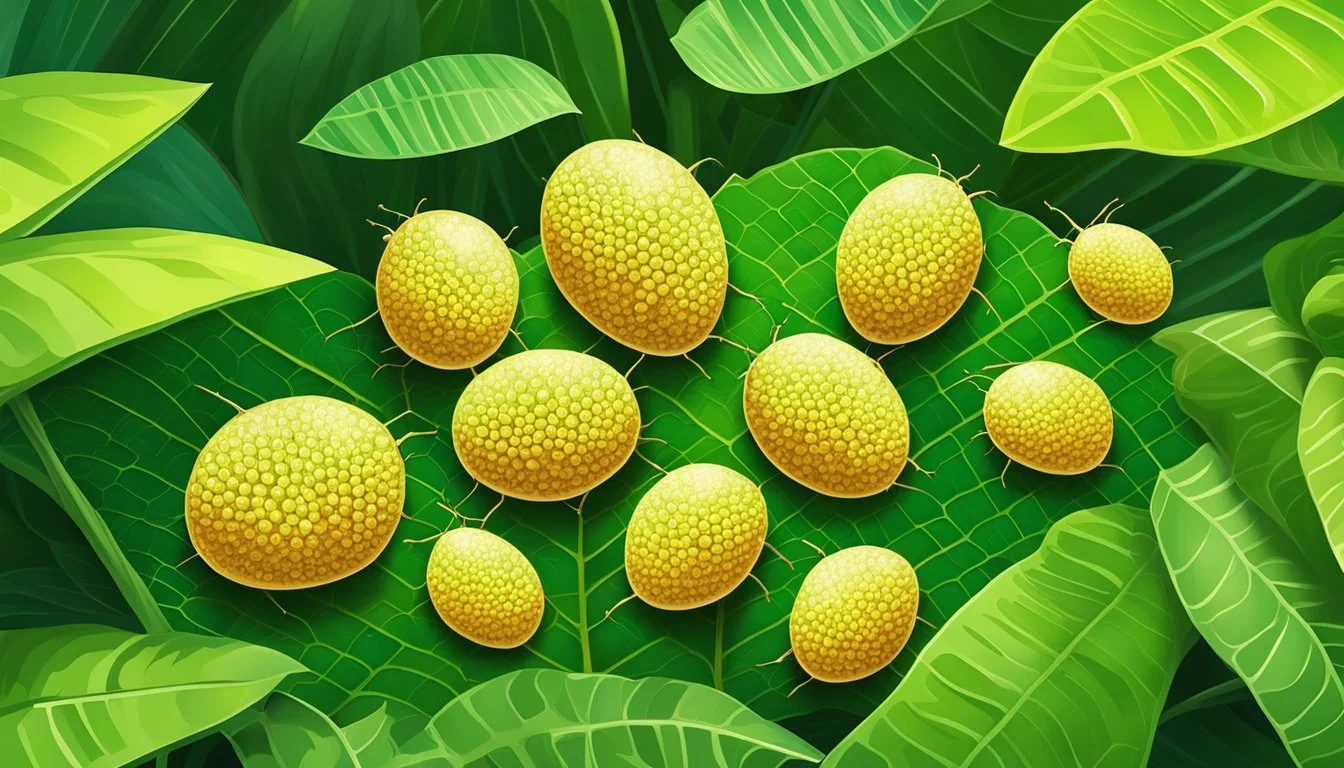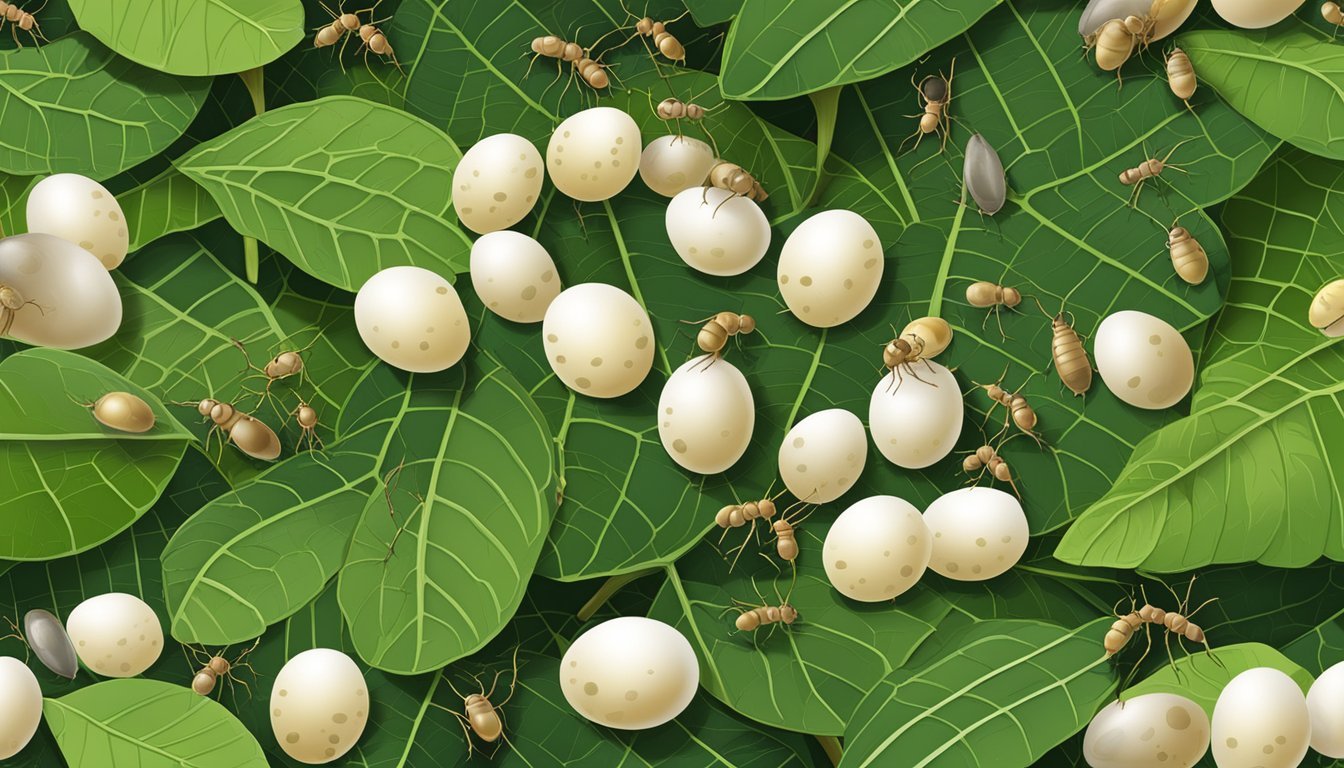Weaver Ant Eggs
Exotic Delicacy in Southeast Asian Kitchens
Weaver ant eggs, known in Thailand as 'kai mod daeng', are a culinary delicacy appreciated across Southeast Asia for their unique taste and texture. Harvested from the nests of the red weaver ant during the dry season, which typically spans from February to May, these eggs are a testament to the region's rich biodiversity and food culture. Esteemed for both their rich, pleasant flavor and potential medicinal properties, they are a seasonal ingredient with a loyal following among local food enthusiasts and adventurous eaters alike.
In areas like Ilocos Sur in the Philippines, dishes featuring ant eggs reflect a harmonious blend of traditional practices and modern gastronomy. The eggs are often showcased in inventive culinary creations, such as the 'abuos tapenade', a fusion of French and Filipino flavors, which brings the local staple to gourmet dining tables. As a source of protein with a nutritional profile offering fewer calories and less fat than chicken eggs, weaver ant eggs not only contribute to savory dishes but also add a nutritional punch.
These edible insect eggs have transitioned from being a localized, exotic food item to capturing the global imagination as a sustainable and alternative protein source. Their usage in Southeast Asian cuisine is not just about flavor but also captures the essence of regional cooking traditions, where resourcefulness and the embracing of nature's bounty have long dictated dietary practices. As more people worldwide develop an interest in sustainable and diverse food options, weaver ant eggs continue to gain recognition on the international culinary stage.
Historical Significance of Weaver Ant Eggs
In Southeast Asia, the harvesting and culinary use of weaver ant eggs hold a significant position in traditional gastronomy. The practice dates back centuries and is embedded in the local heritage of countries like the Philippines and Thailand, showcasing a profound respect for nature’s offerings.
Philippines: In this part of Southeast Asia, abuos—as ant eggs are locally known—are not just a delicacy but a symbol of communal identity and togetherness. Families gather to collect the eggs, which are later prepared in traditional recipes, sautéed with native ingredients like garlic and often paired with soy sauce.
Thailand: Thai cuisine incorporates weaver ant eggs in various dishes, including larb mote daeng, a type of salad that exemplifies the Thai mastery of balancing flavors. The eggs provide a distinctive taste and texture, contributing to Thailand's renowned street food culture.
Nutritional Value: Revered for their nutritional benefits, these edible insects are rich in protein and contain less fat than chicken eggs, making them a favored ingredient among health-conscious consumers.
Culinary Traditions: Across different regions, the use of edible insects like weaver ant eggs is deeply interwoven with the culinary traditions, reflecting an age-old practice of sustainable food sourcing. They serve as a testament to the innovative use of natural resources in local cuisines.
Throughout Southeast Asia, the utilization of ant eggs reflects a rich tradition that has withstood the test of time, and they continue to be cherished as a gourmet ingredient.
Biological and Nutritional Profile
Weaver ant eggs are recognized for their rich nutritional profile and are a highly prized food source in Southeast Asian cuisine. Known for their protein content and bioactive components, these eggs contribute to the region’s dietary practices and agricultural ecosystems.
Species Overview
Oecophylla smaragdina, commonly known as the weaver ant or green ant, are predominantly found in tropical Asia and Australia. These ants are recognized by their distinct orange or red color and are known to construct elaborate nests out of leaves, which they weave together using silk produced by their larvae.
Reproductive Cycle and Harvest
The egg-laying season of weaver ants is crucial for both reproduction and human consumption. Farms specifically for ant egg harvesting have been established, and the process is meticulously timed to coincide with peak egg-laying periods. Larvae and pupae are also collected as these stages are when the ants are most nutritious.
Nutritional Value
Weaver ant eggs, larvae, and pupae present a notable nutritional profile:
Protein: High; over 53%
Fat: Moderate; approx. 13%
Calories: Lower than chicken eggs
Calcium: Present
Phosphorus: Present
Iron: Present
Sodium: Present
Potassium: Present
Vitamin B1: Present
Vitamin B2: Present
Niacin: Present
Compared to conventional chicken eggs, ant eggs contain significantly less fat and fewer calories. They also provide essential minerals such as calcium, phosphorus, iron, and vitamins like vitamin B1, B2, and niacin, making them not only a delicacy but also a healthful addition to the diet.
Culinary Applications
In Southeast Asian cuisine, weaver ant eggs are treasured for their unique flavor and texture, often drawing comparisons to the richness of caviar.
Weaver Ant Eggs in Southeast Asian Dishes
Weaver ant eggs, also known as abuos or itlog ti abuos, are a staple in various Southeast Asian culinary traditions. In the Philippines, particularly in the Ilocos region, these ant larvae are considered the caviar of Ilocos, a rare and indulgent ingredient. They offer a creamy, sweet dimension to the dishes they are incorporated into. Due to the labor-intensive process of harvest and the delicacy's scarcity, dishes featuring weaver ant eggs convey a sense of luxury and celebration.
Popular Recipes and Pairings
The versatility of weaver ant eggs allows for a variety of preparation methods and pairings. Here are a few notable combinations:
Ant Egg Soup: A Laotian delicacy that combines the mild sweetness of ant eggs with the rich flavors of snakehead fish, creating a harmonious blend. Fragrant herbs such as lemon grass, galangal, and basil leaves, along with a tangy hint of tamarind, contribute to the soup's depth.
Abuos Tapenade: Filipino chefs have adapted traditional Provençal techniques to create a distinct fusion, pairing ant eggs with ingredients such as black olives, capers, and olive oil for a rich spread.
Thai Cuisine: In the Isan region, the eggs are often paired with constituents like mango, shrimp, or pork, blending the acidity of the fruit or the savoriness of the meats with the unique texture of the eggs. Thai dishes may further involve a contrast of flavors with incorporation of coconut milk, yielding a creamy, luscious experience.
Laotian Cuisine: Laotian cooks prize the eggs for their ability to complement the flavors of local ingredients such as ginger and coconut palm, adding a touch of sweetness to various traditional dishes.
Regional Variations and Cultural Impact
Weaver ant eggs have long been cherished as a delicacy in various parts of Southeast Asia, offering not just unique flavors but also holding a strong socio-economic significance across communities.
Ant Eggs in Thailand and Laos
In Thailand and Laos, the harvesting and culinary use of weaver ant eggs are particularly notable. Specifically, in Northeastern Thailand or Isan, a region known for its vibrant food culture, dishes incorporating ant eggs reflect the local palate's affinity for pungent and spicy notes. People typically enjoy ant eggs raw, in salads, or as part of a zestful soup. One particular dish to mention is Yum Kai Mod Daeng, a spicy and sour salad made with these eggs.
Laos shares similar culinary practices with its neighbor, often integrating ant eggs into traditional recipes. These eggs add a lemony zest to dishes, which is favored in Laotian cuisine. Meanwhile, street food vendors and restaurants in both countries showcase these eggs, indicating their mainstream appeal in the local food scene.
Socioeconomic Role in Southeast Asia
Weaver ant eggs play a pivotal role in the socioeconomic fabric of rural Southeast Asia. The process of gathering these eggs often forms a low-cost business for rural dwellers, providing them with an economically viable product to sell and consume. Since the methods of collecting these eggs require skill but not advanced technology, it fosters an accessible revenue stream that supports rural life.
Moreover, this practice encourages the transfer of traditional knowledge between younger generations within these communities. As older members teach the art of safely and sustainably harvesting ant eggs, they pass down techniques that have been part of their culture for generations. This tradition not only sustains the local economy but also preserves a culinary heritage that is intricately woven into the region's cultural identity.
Preparation Techniques
In Southeast Asian cuisine, the preparation of weaver ant eggs involves a balance of tradition and innovation, aiming to highlight their unique flavor and texture.
Traditional Preparation Methods
Traditionally, weaver ant eggs are gathered and prepared with an emphasis on preserving their delicate taste and soft consistency. The eggs are often lightly sautéed, which allows them to retain their structure while being imbued with subtle flavors from additional ingredients. A common traditional preparation might include a simple sauté with minimal seasonings, such as salt and local herbs, to let the natural flavor of the eggs stand out.
Sautéing:
Heat a small amount of oil in a pan.
Add the ant eggs and gently stir-fry.
Season with salt and incorporate local aromatics as desired.
Another traditional method is to incorporate the eggs into soups (What wine goes well with soups?), lending a gentle sourness that balances the dish’s flavors. This sourness is sometimes enhanced with the addition of natural souring agents like lemon juice.
Soup Integration:
Ant eggs are added to broths near the end of cooking.
Lemon juice can be added for additional sourness.
Modern Culinary Techniques
Modern chefs often experiment with ant eggs to create new gastronomic experiences. They maintain the integrity of the eggs while introducing contemporary elements. Techniques such as pickling the eggs in a vinegar solution imbue them with the tang of acetic acid without overpowering their natural subtlety.
Pickling:
Submerge ant eggs in a mixture of vinegar and water.
Add spices and seasonings to the pickling solution to enhance flavor.
Innovative chefs also play with texture contrasts by pairing the eggs with crisp ingredients. Grain salads or vegetable stir-fries provide a crunchy counterpoint to the soft, lush eggs.
Ingredient Pairing for Texture:
Serve pickled ant eggs alongside or on top of salads and stir-fries.
Balance textures with appropriate dressings or sauces.
Through both traditional and modern methods, Southeast Asian chefs honor the prized nature of weaver ant eggs by using preparation techniques that underscore their distinctive qualities.
Health and Dietary Consideration
When examining the health impact of incorporating weaver ant eggs into a diet, one finds that they are seen as a nutritious food source. These eggs contain a substantial protein content, akin to that of traditional meats, and offer a variety of essential amino acids critical for bodily functions.
Nutritional Content Comparison:
Protein:
Weaver Ant Eggs (100g): More than 8.2g
Chicken Eggs (100g): Approximately 13g
Fat:
Weaver Ant Eggs (100g): 2.6g
Chicken Eggs (100g): 11.7g
Calories:
Weaver Ant Eggs (100g): Lower
Chicken Eggs (100g): Higher
Essential Minerals:
Weaver Ant Eggs (100g): Calcium, iron, etc.
Chicken Eggs (100g): Similar
Weaver ant eggs have demonstrably less fat than chicken eggs, which can be beneficial for those managing their dietary fat intake. The caloric content is also lower, offering a potentially lighter option for calorie-conscious individuals.
As for their alleged aphrodisiac qualities, there is seldom robust scientific evidence supporting such claims. These assertions are often based on traditional beliefs rather than empirical data.
From a biological standpoint, the consumption of weaver ant eggs aligns with the nutritional habits observed in various cultures that have historically leveraged diverse protein sources. Regarding safety and allergies, individuals should exercise caution similar to any dietary change especially when introducing novel protein sources.
In summary, while weaver ant eggs can enrich a diet with high-quality protein and nutrients, their health benefits should be considered within the context of a balanced diet and individual dietary needs.
Conservation and Sustainability
Weaver ant eggs are considered a culinary delight in Southeast Asian cuisine, but their popularity raises concerns about conservation and sustainable harvesting. Farming weaver ants can offer a low-cost, high-protein food source and is generally recognized as a sustainable practice because these ants can be prolific within their habitat. Sustainable farming practices ensure that ant populations remain stable and natural ecosystems are not disrupted.
Local communities engage in:
Harvesting techniques that do not significantly harm the ant colonies
Monitoring ant population to prevent overharvesting
Utilizing weaver ants in biocontrol, reducing the need for chemical pesticides
The challenge lies in balancing the demand for this ingredient with the need to maintain healthy ant populations. Local ingredients like weaver ant eggs not only support regional economies but also promote food sovereignty and reduce the carbon footprint associated with long-distance food transportation.
Sustainable practices include:
Periodic harvesting to allow colonies to regenerate
Protecting the host trees where ants establish their nests
Proponents of sustainable weaver ant egg collection posit that, with careful management, the practice can coexist with conservation efforts, maintaining a balance that benefits both the environment and the local communities relying on these insects for both food and income.







